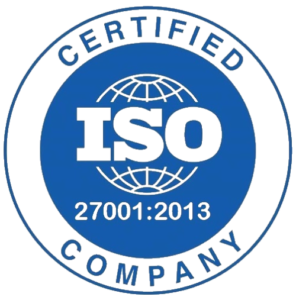Possibly one of the very few positive outcomes of the pandemic, however, was the popularity and mass adoption of virtual events. Because of how widely used the internet is, SMBs can now have their events online, saving a ton of money without sacrificing their worldwide reach.

Airmeet supports virtual events of all sizes, regardless of the budget you’re working with, the number of users involved, or the industry you belong to. But one of the more exciting and interesting reasons we love what we do here at Airmeet is the impact the Airmeet platform can have on smaller businesses.
The challenges SMBs face are sometimes unique, but still universal – like maximizing resource productivity to ensure that everything runs smoothly, effectively, and within budget. For SMBs to invest in a resource-heavy activity like hosting traditional events, it can not only be overwhelming and exhaustive but also extremely expensive – and mind you, without any guarantee of returns.
And this is exactly where a virtual events platform, like Airmeet, can come to your rescue.
Contrary to traditional events, virtual events hosted on Airmeet require far fewer resources, budgets, and planning. Don’t take our word for it. Read on and find out for yourself how you can transform your SMB’s event marketing game with Airmeet.
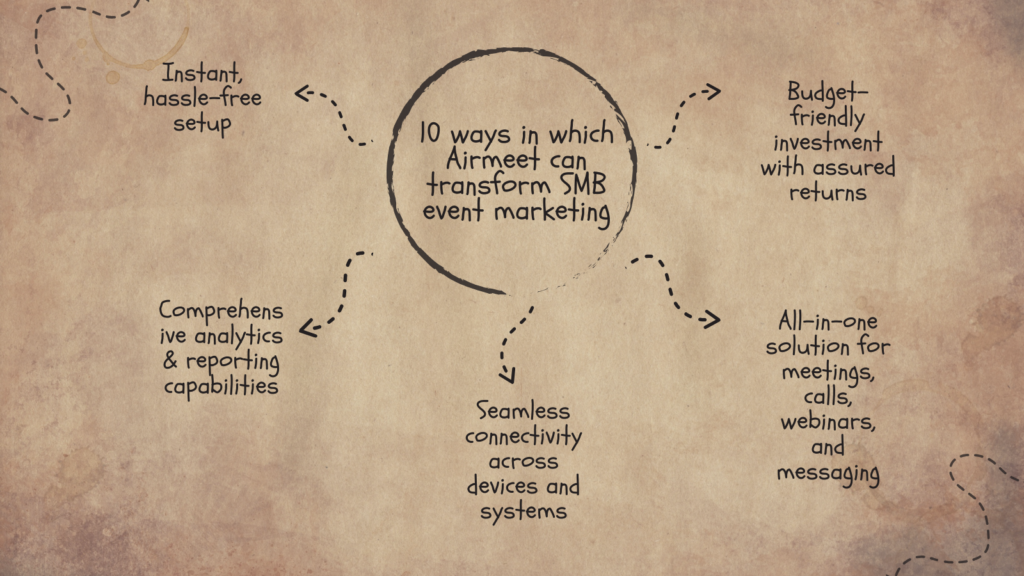
Here are 10 ways in which we make that happen for you:
1. Instant, hassle-free setup
Airmeet enables simple buying and deployment. It only takes one click to initiate or attend a meeting, and Airmeet allows for easy collaboration and participant control. In brief, you do not require any previous technical knowledge to operate Airmeet. Several users have validated the user-friendliness of the platform as well as the intuitive user interface.
2. Comprehensive analytics & reporting capabilities
Airmeet provides powerful analytics that allow SMBs to track attendee activity, measure event success, and gather insights for future marketing strategies. Access to high-quality data is one of the biggest benefits of investing in a virtual events platform like Airmeet. You can understand the overall success of the event, and also dig into the finer details of what could have been done better. Taking a data-driven approach to plan your next event allows you to consistently deliver the best event experience for your attendees.
3. Seamless connectivity across devices and systems
Airmeet works flawlessly across all operating systems – Mac, Linux, iOS, and Android—so your staff is not limited to certain platforms.
4. All-in-one solution for meetings, calls, webinars, and messaging
Using a single solution for video meetings, webinars, cloud phone calls, and group chats empowers you to make better use of your resources and streamline event-related efforts for your team. Centralizing multiple touchpoints improves efficiency, saves time, cuts costs and most importantly, increases your chances to deliver a seamless event experience.
5. Budget-friendly investment with assured returns
Hosting virtual events on Airmeet eliminates the need to invest in venue rentals, catering, and travel expenses, and everything else that goes into the execution of a traditional in-person event. This makes it a cost-effective option for SMBs with limited budgets and resources.
Also, given the multitude of functionalities and capabilities you have access to with Airmeet, you get to create a stellar SMB event marketing strategy to set you up for long-term success.
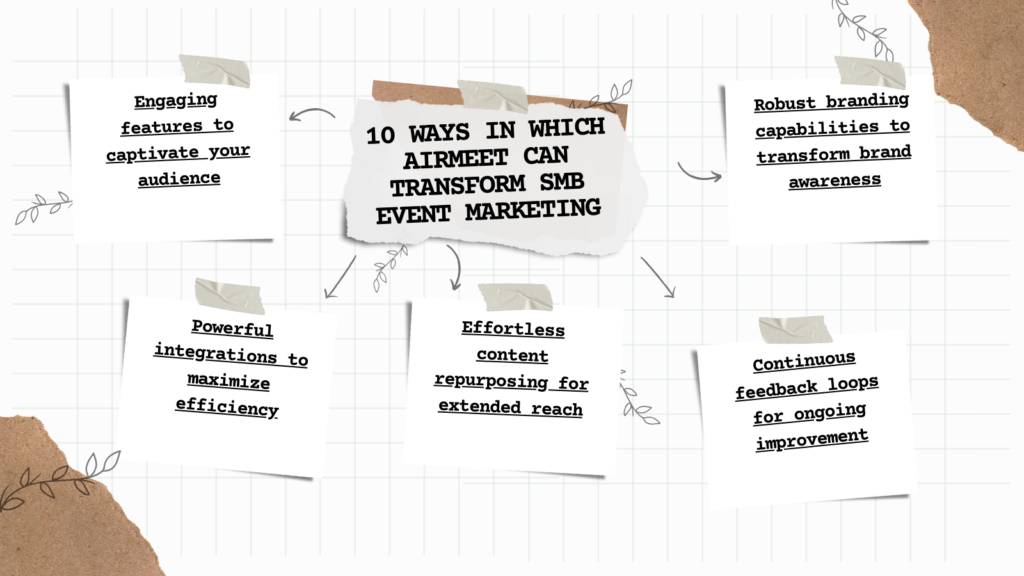
6. Engaging features to captivate your audience.
Airmeet offers interactive features like live polls, Q&A sessions, and breakout rooms to encourage active attendee engagement and create memorable experiences. Airmeet provides virtual networking lounges and one-on-one meeting capabilities, enabling SMBs to facilitate meaningful connections between attendees, partners, and industry influencers.
With Airmeet’s dynamic customization, branding capabilities, and sponsorship placements, you can showcase your brand identity and gain visibility among attendees.
7. Powerful integrations to maximize efficiency
Our connections with Google and Microsoft will help you expedite your meetings, and our App Marketplace offers over 30 connectors with popular apps like Slack and PayPal. Moreover, custom integration options are available within Airmeet, allowing you to maximize its potential according to your specific needs.
8. Effortless content repurposing for extended reach.
With Airmeet, you get to record your events and repurpose the content for marketing purposes. This includes creating promotional videos, blog posts, or social media content. This empowers you to extend the shelf-life of your event and maximize your returns as well as your reach. Share the recording as it is with people who registered but couldn’t attend the event. Target a new audience with videos, takeaway reports, and so much more.
9. Continuous feedback loops for ongoing improvement.
At Airmeet, we believe real-time feedback and post-event surveys allow SMBs to gather meaningful event insights to continuously improve their event marketing strategies. Airmeet also facilitates the creation of online communities around specific topics or industries, enabling SMBs to nurture relationships with their audience beyond individual events.
10. Robust branding capabilities to transform brand awareness
Branding elements and customization components are crucial for improving marketing effectiveness. SMBs can optimize Airmeet features to enhance their brand presence through their events. The virtual event platform empowers the SMB’s marketing team to incorporate logos, banners, welcome videos, and background images.
Event planners can customize every bit of their event, from registration forms to email templates to sponsor/exhibitor booths. This not only enables event organizers to showcase their brand but also offers sponsors or exhibitors the opportunity to personalize their booth spaces, creating a marketplace within a unified platform.
Must-Have Features to Customize Event Marketing Efforts
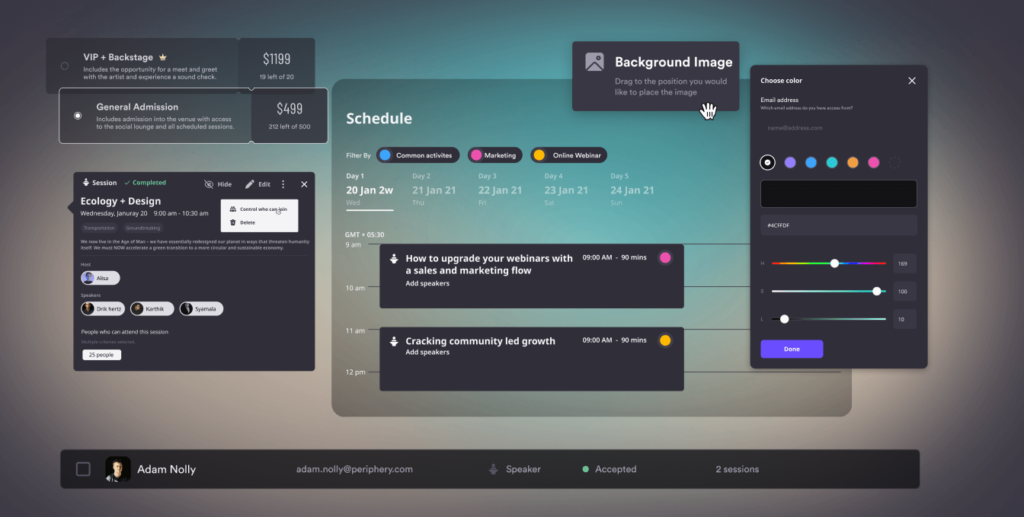
Since brand recall is crucial for every SMB to stand out in the sea of competition, Airmeet provides a range of customization functionalities to assist you with your every need.
Tailor your events to your preferences and to your specific business goals and deliver a consistent brand story, at every touch point, to maximize the impact of your event.
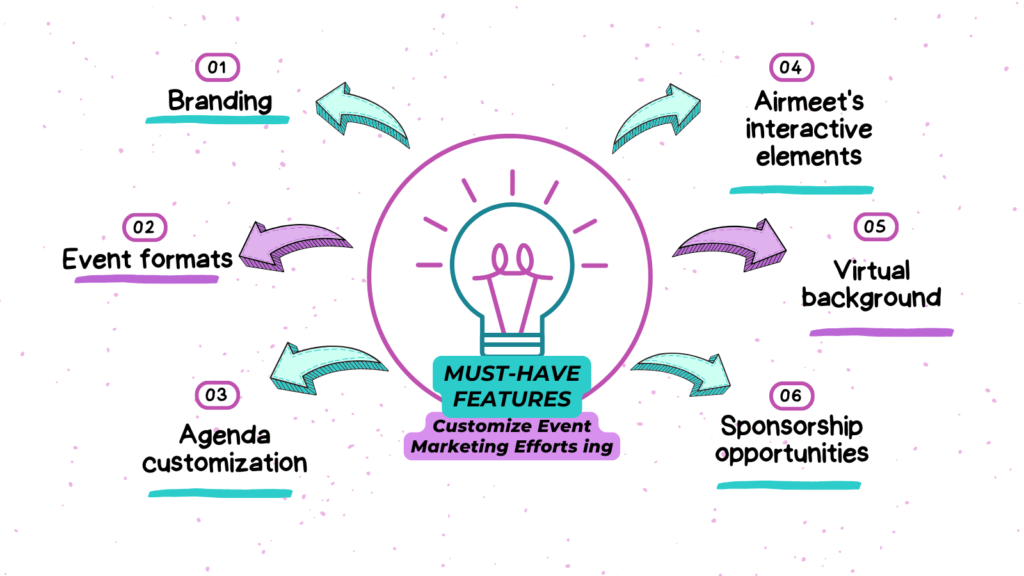
Here are some customizations we provide:
- Branding: You can personalize your SMB event’s branding by customizing event landing pages, incorporating your company logo, colors, and banners to maintain a cohesive brand experience for attendees.
- Event formats: Airmeet offers a variety of event formats, including webinars, virtual summits, seminars, networking events, and more, allowing SMBs to select the format that best meets their goals and objectives.
- Agenda customization: Create a specific agenda for your event and include session titles, timings, presenter names, and descriptions.
- Airmeet’s interactive elements: This feature includes surveys, Q&A sessions, chat rooms, and networking lounges, allowing SMBs to drive engagement and conversation among participants.
- Virtual background: Personalize your virtual backdrops for speakers and presenters by adding brand elements or custom create a visually appealing backdrop that adds to the overall event experience.
- Sponsorship opportunities: Airmeet enables SMBs to include sponsor logos, adverts, and promotional materials in their events, allowing for revenue and partnership partnerships.
A step-by-step Guide To Create an effective SMB Marketing Plan
1. Identify your target audience

Regardless of the size of the company, one of the most vital prerequisites of any marketing unit is how well you understand your target audience and potential customers. Run surveys, conduct market research, and identify who your audience is. The finer the details of the research, the higher the chances of success. It’s also important to identify what brand message you’re currently narrating to your audience, what products or services define you, and what your marketing goals are.
2. Understand the market you’re in
Nest, analyze the market and where your SMB stands, vis a vis the consumer trends, competition, and demand-supply aspects of the industry, among other factors.
Understanding the market allows you to identify the existing gaps that you can fill with your product or service and position your brand accordingly through your marketing efforts.
3. Identify the Opportunities and Threats
Be realistic about the opportunities and the threats that exist in the market for your brand, as well as your company. This way, you can afford to have a more informed strategy to tackle the threats, make better and faster decisions on the opportunities to pursue and create an overall marketing plan that guarantees sustained growth.
4. Set Goals & Objectives
Once your research is done, it is time to define your goals – marketing goals that are realistic and achievable. Assign deadlines to each of them, define the goal in as much detail so there is no ambiguity in what you pursue over the next month/ quarter/ year.
Depending on your resources, budget and other factors, define your goals such that they are aspirational, but not overwhelming. Assign regular target review timelines as well, to check the progress you’ve made, and to tweak whatever needs to be revised, if at all.
5. Create a Plan of Action
Using the goals as your guidelines, create a plan of action to achieve those goals. Take a step-by-step approach and break down the goals into smaller achievable tasks, assign ownership for each task and a deadline.
Create a thorough plan and, if needed, possible alternatives should the need arise. Spell out every last detail in your action plan to minimize confusion and ambiguity later on. By the end of this step, every member of your team should be aware of their role, their tasks for the week/month/quarter, their deadlines, and their short-term goals.
6.Evaluate the progress

To run a smooth marketing team, you need to account for flexibility and resilience in everything you do. This is because there are several variables that one may or may not be able to envision, while creating the plan. So, it is paramount to revisit your marketing plan every once in a while – could be monthly or quarterly – to evaluate if your plan is moving along as it should.
Upon evaluation of all metrics, if you realize everything is moving along perfectly, then perhaps it is time to adjust your goals to make it slightly more aspirational. Push the envelope to see if you can reach higher.
And if the progress does not seem as smooth and promising as you’d planned, take a step back and adjust your strategy to tackle the obstacles hindering your progress. Tweak the timelines to make it more realistic, or assign more resources towards the more pressing roadblocks.
Get your team to be involved in the process to have a better understanding of where you lag. Review the progress you’ve made again in a few weeks to see if Plan B has worked. If not, repeat until you have successfully achieved your goals.
FAQ
Yes, Airmeet offers integration capabilities to help SMB (Small and Medium-sized Businesses) event marketing initiatives. Airmeet integrates with a variety of prominent marketing solutions, including HubSpot, Mailchimp, Salesforce, and Marketo. These interfaces enable SMBs to effortlessly integrate their event marketing efforts with their existing marketing workflows, allowing them to promote their events more effectively, acquire leads, and monitor engagement.
Small and medium-sized companies (SMBs) use social media platforms to improve their digital marketing strategies by taking advantage of the broad reach, targeting capabilities, and interaction possibilities provided by platforms like Facebook, Instagram, Twitter, LinkedIn, and others.
SMBs may develop captivating material, such as posts, photographs, videos, and stories, suited to their target audience’s preferences and interests, and distribute it across multiple social media channels to raise brand recognition, drive website traffic, and generate leads.
An event marketing checklist may dramatically improve SMBs’ event marketing strategy by offering a thorough and methodical structure for planning, execution, and assessing the event’s success.
SMBs can ensure that they cover all essential aspects of event marketing by using a well-organized checklist, which includes setting clear objectives, defining the target audience, creating compelling content and promotional materials, selecting appropriate channels for promotion, managing logistics, engaging with attendees, and measuring key performance indicators (KPIs) to assess the event’s impact.
Optimizing event landing pages is critical for successful event marketing. Here are a few
best practices to follow:
- Clear and captivating title
- Engaging visuals
- Compelling text
- Call-to-action (CTA)
- A/B testing











